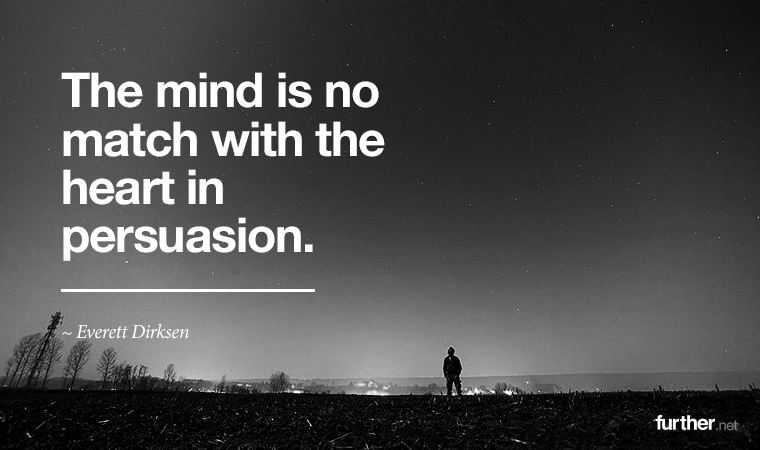
further: feature
When it comes to convincing others to act in the way you’d hope, both heart and mind need to be involved. Of course “heart” is also in our heads, as an emotional connection rather than a purely rational one.
If you’ve had any sales training, studied copywriting, or explored ancient principles of rhetoric, you know that you must stress benefits, not features (this can be a product feature, or a descriptive fact of the case you’re making). People must be expressly told what reward they can expect by agreeing with you.
This all boils down to basic psychology and an understanding of what truly motivates the person you’re trying to reach. But what’s really going on inside our brains when we’re presented with the right beneficial promise at the right time?
Neurological research reveals some fascinating things about how our brains react to anticipated rewards. It seems that a message that focuses on rewards can trigger the same brain activity that results from actually experiencing the reward itself.
This is how Read Montague, neuroscientist and director of the Human Neuroimaging Lab and Computational Psychiatry Unit at the Virginia Tech Carilion Research Institute, puts it:
-
We made some headway at understanding broadly the underpinnings of why certain messages might gain behavioral power. They come to act like rewards, and the rest of the brain adapts itself to predict and acquire them.
Events that foreshadow these potent messages also accrue value because our brains are designed to transfer value to events that predict reward. Just like, “A friend of my friend is also my friend,” the brain has its own version, “A predictor of a predictor is also a predictor,” where the predictors predict future reward.
This is exactly why even complex verbal descriptions like the “… salad of perfectly grilled woodsy-flavored calamari …” can set off reward-seeking circuits. It’s a proxy for the reward to come.
So, when you focus on beneficial messages, you’re creating an anticipatory response that is no different from experiencing the reward itself. A dry recitation of features or purely logical points is not going to pull this neurological trigger, and that’s why messages that focus on features alone fail.
You’ve got to tell people the story they (and their brains) want to hear. And that means how you tell that story matter immensely.
The hardest thing for many people is mistaking features or logical argument points for the benefits that they provide. A feature is a descriptive fact of your argument. The benefit of that feature is what someone gains or avoids losing as a result of that feature.
So, how do you successfully extract true benefits from features? Here’s a four-step process that works:
- First, make a list of every feature of your product, service, or argument.
- Second, ask yourself why each feature is included in the first place.
- Third, take the “why” and ask “how” does this solve existing problems and desires?
- Fourth, get to the absolute root of what’s in it for others at an emotional level.
Let’s look at a product feature for a fictional “content discovery” app:
Feature:
“Contains an artificial intelligence algorithm.”
Why it’s there:
“Adds greater utility by adapting and customizing the user’s information experience.”
What’s in it for them:
“Keeps the data you need the most at the forefront when you’re in a hurry.”
Emotional root:
“Add meaning and value to your life, without getting overwhelmed.”
Easy, right? Just remember, to create a win-win (which is really what ethical persuasion is all about), the reward has to be desired and delivered. One of the biggest factors in real world influence is trust, and all the promised benefits in the world won’t work if you lose that.
Further Exploration:
- Your Brain Is (Almost) Perfect: How We Make Decisions
- Copywriting 101
- How to Locate and Define Benefits
It’s a bit ironic … if you want to persuade others, stress benefits. If you want to be happy in your own pursuits, focus on process instead of rewards. No one said life was logical.
further: health
10 Days to Better Eating
“We designed this 10-day dinner challenge to show that clean eating really can be easy and incredibly delicious. We know it’s difficult (and frankly exhausting) to always think about making healthy choices, so this challenge just focuses on weeknight dinner habits—and maybe lunch if we have some leftovers.”
Join Greatist’s 10-Day Clean Eating Dinner Challenge!
further: wealth
Get Friendly at Work
“When friends work together, they’re more trusting and committed to one another’s success. That means they share more information and spend more time helping — and as long as they don’t hold back on constructive criticism out of politeness, they make better choices and get more done.”
further: wisdom
Do the Right Thing
“Just do the next right thing. It will be okay.”
That simple concept simultaneously gave Michael Hyatt relief and clarity. He’s used it time and time again in moments when he has felt overwhelmed and uncertain. Here are the three steps he takes.
What to Do When You Don’t Know What to Do
__________
Want to appear smart, helpful, and generous? To be the kind of person others follow religiously on social media because of your impeccable editorial taste?
That’s right, simply share Further. See what I did there?
Keep going-
Brian Clark
Tour Guide
Further
